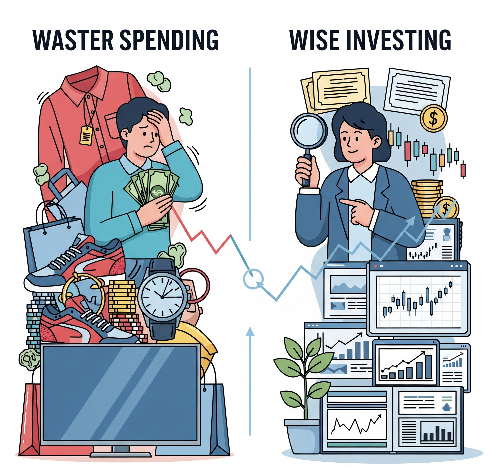The Money Game: The 3 Phases to Stop Spending and Start Building
Have you ever dreamed of being a millionaire? Most people would say yes. But if you think about it, the real reason for that desire isn't the freedom of not working, but the idea of being able to spend without limits.
In his acclaimed book, "The Psychology of Money," which has sold millions of copies, author Morgan Housel explains a very simple truth: people want money to spend it, not to manage it. The key to personal finance isn't how much you earn, but how you behave with what you earn.
To understand this concept and transform your financial life, you need to master three key phases.
Phase 1: The Foundation. Earn and Use Your Money Wisely.
Before you can grow your money, you need to have it. If you currently depend on a single source of income, you're like a table with only one leg: any setback can make it fall. The key is to build more sources of income so you don't depend on just one.
In the beginning, this means exchanging your time for money. Whether as an employee or a freelancer, you're generating active income. The real challenge comes next: knowing how to use it.
Every dollar you earn is a piece of your life you invested. If you spend it on unnecessary things, you're throwing your time away. To build a financial future, you must stop thinking short-term. Don't fall into the cycle of working all week just to spend it all on the weekend.
The idea is simple: never spend everything you earn. Use a portion for your long-term growth.
Phase 2: The Producer Mindset and the Emergency Reserve.
Once you have an income, the next step is to stop thinking like a consumer and start thinking like a producer.
A consumer with $1,000 in hand only thinks about what to spend it on: clothes, parties, gadgets. A producer, on the other hand, sees that $1,000 as a seed. Their question is: "How can I use this money to create more wealth?"
Being a producer means using your money as a resource for growth. This could be by investing in yourself (a new course, a language), creating a personal project, or buying assets that generate more money.
In this phase, a crucial step is to build an emergency reserve. It's your financial cushion. Most experts recommend having at least six months of your monthly expenses saved. This will give you peace of mind and protect you from any financial emergencies.
Phase 3: The Ultimate Goal. Create Passive Income.
Once you have multiple sources of income and a solid emergency reserve, you're ready to enter the phase of financial freedom.
Here, the goal is to make your money work for you. If you invest, your assets will generate returns that, with time and compound interest, will turn into an unstoppable "snowball."
This is the true meaning of having a million dollars to manage, not to spend. It's what differentiates true investors.
The key isn't to have a huge return, but to start early. The investor Warren Buffett became incredibly wealthy because he started at a very young age, allowing time to work its magic with compound interest.
To reach this phase, you don't need to look rich with expensive clothes or cars. You need to qualify yourself, increase your income, and invest a portion of it. The path might seem overwhelming at first, but the most important thing is to take the first step.
Start today by seeing your money not as an end, but as a tool to build the life you truly deserve.

